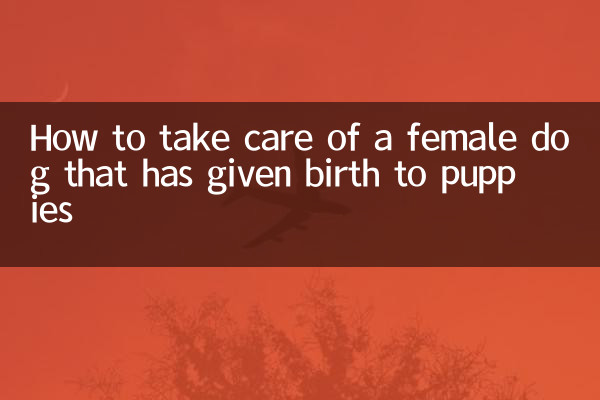How to Care for a Parenting Female Dog: A Comprehensive Guide
Caring for a pregnant female dog is a job that requires care and patience. Whether you are a first-time dog owner or an experienced dog owner, you need to understand the special needs of your female dog before and after giving birth. This article will provide you with a comprehensive guide to help you better care for your female dog in labor.
1. Preparation before delivery

Before your mother gives birth, you need to be fully prepared to ensure the safety of your mother and puppies. Here are some key steps:
| Preparation | Specific content |
|---|---|
| Delivery room layout | Choose a quiet, warm, dry place as the delivery room and lay it out with clean towels or mats. |
| diet modification | One week before delivery, gradually increase the amount of food the bitch eats and choose high-nutrition dog food. |
| health check | Take the mother dog to the veterinarian for a prenatal check-up to make sure the mother dog and puppies are in good health. |
2. Care during delivery
When your female dog is giving birth, you need to remain calm and observe her closely. Here are some things to pay attention to during childbirth:
| Things to note | Specific content |
|---|---|
| Observe the female dog’s behavior | The female dog may show restlessness, panting, or frequent licking of the vagina, which are normal signs of labor. |
| Assisted delivery | Most bitches can complete labor on their own, but if the bitch shows signs of dystocia (such as no puppies for more than 2 hours), you should contact your veterinarian immediately. |
| clean up puppies | Mother dogs will usually lick their puppies to clear the membranes, but if the mother fails to do this, you can gently wipe the puppies with a clean towel. |
3. Postpartum care
After giving birth, both the mother dog and the puppies require special care. The following are the key points of postpartum care:
| Nursing points | Specific content |
|---|---|
| diet nutrition | After giving birth, female dogs need high-calorie, high-protein food, and you can choose special lactation dog food. |
| keep clean | Change the mats in the delivery room regularly to keep the environment dry and clean to avoid bacterial infections. |
| Observe health status | Pay attention to whether the female dog has fever, loss of appetite or abnormal secretions. If there is any abnormality, seek medical treatment in time. |
4. Puppy care
The health and growth of puppies are also inseparable from the care of the mother dog. Here are the key points of puppy care:
| Key points | Specific content |
|---|---|
| breast-feeding | Make sure that the puppies can eat breast milk smoothly. If the mother dog's milk is insufficient, you can consider using milk powder to supplement it. |
| keep warm | Puppies are temperature sensitive and need to keep their environment warm, using heating pads or heat lamps. |
| Regular inspection | Take your puppy to the veterinarian regularly for health checkups to make sure it is growing and developing normally. |
5. Frequently asked questions and solutions
There are some common problems you may encounter while caring for a pregnant female dog. Here are these problems and their solutions:
| FAQ | solution |
|---|---|
| Female dog refuses to breastfeed | It may be due to pain or stress, so try to soothe the bitch or consult a veterinarian. |
| Puppies not gaining weight | There may be insufficient breast milk or a health problem with the puppy, so you should seek medical attention promptly. |
| Postpartum depression in bitches | Give the female dog more love and companionship, and seek veterinary help if necessary. |
Summarize
Caring for a pregnant female dog requires thorough preparation and careful observation. From preparation before delivery to care after delivery, every step is crucial. With the guidance in this article, you can better help your mother dog through this special period and ensure the health and safety of her and her puppies.
If you have any questions or encounter special circumstances, it is recommended to consult a veterinarian in time to obtain professional guidance and help.

check the details

check the details